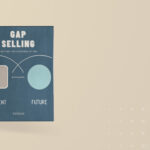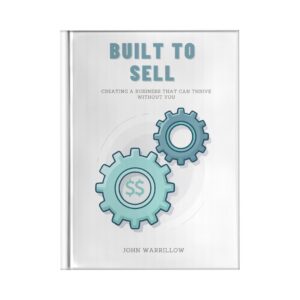
Book Summary: Building a Second Brain by Tiago Forte
April 27, 2025
Book Summary: Gap Selling by Keenan
May 4, 2025Built to Sell Summary: How to Turn an Owner‑Dependent Service Firm Into a Scalable, Sellable Asset
Why This Built to Sell Summary Matters for Owner‑Led Businesses
If your agency, consultancy, or creative studio can’t run without you, this built to sell summary will show you how John Warrillow’s classic book can change everything. Built to Sell argues that owner dependency kills valuation, slows growth, and traps founders in day‑to‑day grind. By following Warrillow’s framework—specialization, productization, systemization, and a well‑managed exit—you can create a business that commands a premium multiple and frees up your life at the same time.
The Options Strategy: Build to Last and Maximize Sale Value
“Run your company as if it will last forever, yet design it so you could sell tomorrow for top dollar.” —John Warrillow
Warrillow calls this dual mindset the options strategy. You want three outcomes:
- Owner independence—the firm thrives whether or not you show up.
- Higher valuation—strategic buyers pay more for a business that scales.
- Choice—sell, stay on as chairman, or keep growing; the power is yours.
A predictable, process‑driven company makes all three outcomes possible.
Built to Sell Summary Roadmap: The Eight Essential Shifts
Below is a quick reference table before we dive deeper.
| Shift | Goal | Key Result |
|---|---|---|
| Specialize | Narrow to one teachable, valuable service | Clear brand & higher margins |
| Productize | Turn that service into a repeatable “product” | Value‑based pricing |
| Systemize | Document SOPs & workflows | Consistent delivery without you |
| Sales Engine | Hire at least two reps & track funnel | Predictable revenue growth |
| Cash Flow | Charge up‑front or via retainers | Positive cash cycle & stability |
| Client Mix | No single customer > 15 % of revenue | Reduced buyer risk |
| Brand Language | Talk like a product company | Premium positioning |
| Exit Process | Teaser → LOI → diligence → close | Maximum valuation, minimum earn‑out |
Step 1: Specialize—Create a Standard Service Offering (SSO)
Generic agencies drown in bespoke projects; buyers hate that complexity. Warrillow’s cure is the Standard Service Offering—one tightly defined, high‑value service that every team member can deliver.
How to Build Your SSO
- List everything you sell. Rank each item by (a) client value and (b) ease of teaching.
- Pick the sweet spot. Choose the service that scores high on both axes.
- Give it a name. “Five‑Step Logo Sprint™” or “7‑Day Finance Dashboard.”
- Price it as a product. Fixed scope, fixed timeline, fixed fee.
Saying “no” to everything outside your SSO signals seriousness and makes referrals razor‑sharp—an essential step toward creating a sellable business.
Step 2: Productize—Deliver Consistency at Scale
With one service chosen, turn it into a repeatable product. Think checklists, templates, and timelines clients can review before signing. Productizing services lets you:
- Quote value‑based prices rather than hourly rates.
- Forecast workload and hire staff ahead of demand.
- Train new employees quickly using documented SOPs.
Buyers equate productization with predictability—critical for a premium valuation.
Step 3: Systemize—Document Processes So the Business Runs Without You
Owner reliance tanks deals, so this stage is vital to any built to sell businesses. Create an internal wiki or operations manual covering:
- Sales scripts and qualification criteria
- Step‑by‑step project workflows
- Quality‑control checklists
- Client hand‑off procedures
When everything is documented, you can step away and the wheels keep turning—proof your company is a business that doesn’t rely on the owner.
Step 4: Build a Predictable Sales Engine
A sellable enterprise needs revenue that flows without the founder closing every deal. Warrillow recommends hiring two sales reps to show scalability and to create healthy competition.
Key metrics to track:
- Lead‑to‑opportunity conversion
- Proposal win rate
- Average deal size
- Sales cycle length
Publish these numbers in your pitch deck; acquirers love data they can model.
Step 5: Optimize Cash Flow and Recurring Revenue
Built to Sell hammers home that cash flow is king. Shift from invoicing after delivery to:
- Up‑front payments (e.g., 50 % deposit, 50 % on completion).
- Milestone or progress billing tied to your process steps.
- Retainer or subscription models for ongoing support.
Positive cash flow reduces financing risk for buyers, boosting your EBITDA multiple.
Step 6: Balance Your Customer Portfolio—Follow the 15 % Rule
If one client supplies more than 15 % of revenue, buyers will fear churn and push for an earn‑out. Diversify by:
- Raising prices to recruit smaller clients.
- Creating tiered packages to attract mid‑market accounts.
- Automating marketing funnels to widen your lead base.
Healthy customer spread = stronger negotiating power when you exit.
Step 7: Rebrand Your Optics—Sound Like a Product Company
Language matters. Swap “clients” for customers, “projects” for products, and “engagements” for contracts. List fixed prices online. Stop pitching bespoke work. These shifts:
- Reinforce your niche expertise.
- Make cost comparisons easier for prospects.
- Help acquirers see a plug‑and‑play product line, not a custom job shop.
Step 8: Navigate the Exit—From Teaser to Close
Built to sell exit strategy framework
- Teaser – a blind one‑pager sent by your advisor to select acquirers.
- NDA & CIM (“The Book”) – detailed financials, market size, and growth levers.
- Management presentation – show that the team, not you alone, drives results.
- LOI – negotiate price, deal structure, and earn‑out (aim to minimize).
- Due diligence – the “proctology exam.” Have clean books, SOPs, and legal docs ready.
- Purchase agreement & transition – agree on post‑sale role; 12–24 months max keeps momentum without founder fatigue.
Strategic buyers—those who gain synergies—usually pay more than financial buyers, so cultivate multiple suitors to spark a bidding war.
Frequently Asked Questions (Built to Sell Summary Edition)
What is the core takeaway of Built to Sell?
Specialize, productize, systemize, and build owner independence so you can scale and eventually sellable business at a premium.
How do I reduce owner dependency?
Document every process, delegate client relationships to account managers, and install a non‑founder sales team.
What is a Standard Service Offering?
A branded, step‑by‑step service product with fixed scope and price—easier to sell, fulfill, and scale.
Why is recurring revenue so powerful?
Predictability lowers risk for buyers, boosting valuation multiples—often 2‑4 × higher than project‑based firms.
Is Built to Sell useful for SaaS, e‑commerce, or manufacturing?
Yes. Although the book targets service businesses, the principles of specialization, systems, and exit planning translate well.
What mistakes kill deals?
Entering talks with one buyer, hiding owner reliance, and having lumpy client concentration—all fixable with Warrillow’s roadmap.
Action Plan: Start Implementing Built to Sell Principles Today
- Map every service you offer; kill low‑margin one‑offs.
- Choose your SSO, give it a memorable name, and price it.
- Write SOPs for marketing, sales, delivery, and support.
- Hire or upskill two sellers; set lead and win‑rate targets.
- Shift billing model—deposits, milestones, or subscriptions.
- Track the 15 % rule monthly and diversify if any client creeps up.
- Use product language in proposals and on your website.
- Meet a succession‑focused accountant before you list for sale.
Each step moves you closer to a company that can run without you—and fetch top dollar when you decide it’s time.
Final Word: Build a Business, Not a Job
This built to sell summary demonstrates that creating a truly sellable company isn’t a mystery; it’s a method. Specialize, systemize, and scale—then decide whether to keep, cash out, or step back. Either way, you’ll own a real asset instead of an all‑consuming job. And that, as John Warrillow reminds us, is the ultimate entrepreneurial freedom.


